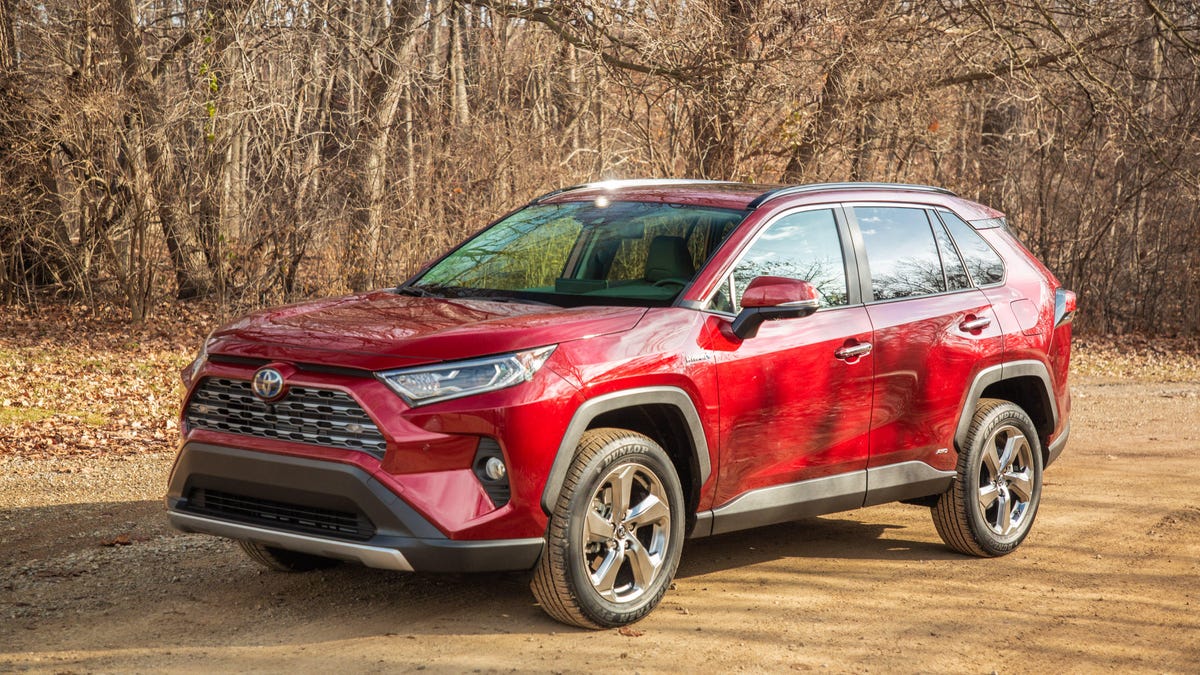2020 Toyota RAV4: Model overview, pricing, tech and specs
Toyota's compact SUV adds a new TRD Off-Road trim for 2020, and a plug-in hybrid model is on the horizon, too.
The Toyota RAV4 is the best-selling crossover in America. With the introduction of the fifth-generation RAV4 in late 2018, Toyota was smart to not shake up the SUV's overall formula, but to keep it competitive in key areas. It might not be our first choice for a compact crossover, but it's easy to see why these things fly off dealer lots. As far a well-rounded vehicles go, the RAV4 is a solid choice.
Because the RAV4 was fully redesigned for 2019, it enters 2020 with only minor changes. The most significant update is the addition of a TRD Off-Road trim, which gets a retuned suspension, off-road tires and some styling tweaks. Otherwise, the RAV4 stays the course as we head into 2020, and that certainly isn't a bad thing.
- Click here to read our most recent Toyota RAV4 review.
- Click here to read our most recent Toyota RAV4 Hybrid review.
Powertrain and specs
Toyota currently offers its compact SUV in RAV4 and RAV4 Hybrid guises. At the end of 2019, Toyota will add a third, plug-in hybrid model to the RAV4 range, offering a larger battery for small amounts of all-electric operation.
The standard RAV4 is powered by a naturally aspirated, 2.5-liter I4 engine, which produces 203 horsepower and 184 pound-feet of torque, and is mated to an eight-speed automatic transmission. Certain RAV4 trims come with stop-start engine tech, which helps to improve efficiency. Front-wheel-drive models are EPA-estimated to achieve up to 28 miles per gallon city, 35 mpg highway and 30 mpg combined. All-wheel-drive RAVs, meanwhile, top out at 27 mpg city, 34 mpg highway and 30 mpg combined.
The RAV4 Hybrid pairs the aforementioned 2.5-liter I4 with a nickel-metal hydride battery and electric motor, for 219 total system horsepower. All hybrid models use a continuously variable transmission (CVT) as well as an electronic "on-demand" all-wheel-drive system, which uses the electric motor to supplement four-wheel power. The EPA says RAV4 Hybrids are estimated to achieve 41 mpg city, 38 mpg highway and 40 mpg combined -- decent increases over the gas-only variant.
In our multiple reviews, we've found the RAV4's engine to be a little on the loud/coarse side, but pretty fuel-efficient. The RAV4 isn't quite as pleasant to drive as a Honda CR-V or Mazda CX-5 , but it offers a smooth balance that most consumers will likely appreciate.
Though towing is certainly not the RAV4's forte, owners can still hook up a small trailer if needed. The gas-only RAV4 is rated to tow 1,500 pounds, while the extra oomph of the RAV4 Hybrid ups that rating to 1,750 pounds.
Interior
All RAV4 models can accommodate five passengers, with a second-row bench seat that folds flat for increased cargo capacity. Overall, the RAV4's interior is about average for the class -- the design is fine, and relatively straightforward, but some of the materials are a little sub-par. Cloth and leather seating options are available, depending on trim, as are comfort and convenience features like heated seats, a power sunroof, automatic climate control and more.
Regardless of model -- and drivetrain -- all RAV4s offer the same cargo capacity. With the second-row seats upright, you'll find 37.6 cubic feet of space for storage. Fold those seats flat, however, and the cargo hold expands to 69.8 cubic feet.
Technology
Depending on model, the RAV4 uses either a 7- or 8-inch touchscreen multimedia display, all of which come standard with Apple CarPlay, Android Auto, Amazon Alexa compatibility, Bluetooth and more. Niceties like embedded navigation, HD radio and a JBL premium sound system are available on higher-end models.
Overall, Toyota's Entune 3.0 system is good, but not great. The graphics look slightly out of date, and the system sometimes lags when responding to inputs. Still, there's a lot of functionality built in, and certain RAV4s come with a Wi-Fi hotspot to access connected-car apps. A wireless charging pad is available, too.
Where the RAV4 really excels is in its driver-assistance tech -- or rather, how much of it is standard. All RAV4s come with the Toyota Safety Sense 2.0 suite, which includes precollision braking with pedestrian detection, lane-departure assist, lane-tracing assist, automatic high-beam assist, full-speed adaptive cruise control and traffic sign assist.
Pricing
The 2020 Toyota RAV4 has a broad pricing range, from $26,770 for a LE FWD model, to $36,970 for a Hybrid Limited with all-wheel drive. (All pricing information includes $1,120 for destination.) Here's an individual pricing breakdown for all the RAV4 models.
- RAV4 LE FWD: $26,770
- RAV4 LE AWD: $28,170
- RAV4 XLE FWD: $28,570
- RAV4 Hybrid LE AWD: $28,970
- RAV4 XLE AWD: $29,970
- RAV4 XLE Premium FWD: $30,770
- RAV4 Hybrid XLE AWD: $30,775
- RAV4 XLE Premium AWD: $32,170
- RAV4 Adventure AWD: $34,170
- RAV4 Limited FWD: $34,770
- RAV4 Hybrid XSE AWD: $34,970
- RAV4 Limited AWD: $36,170
- RAV4 TRD Off-Road: $36,300
- RAV4 Hybrid Limited AWD: $36,970
Availability
The 2020 Toyota RAV4 and RAV4 Hybrid are available now.


